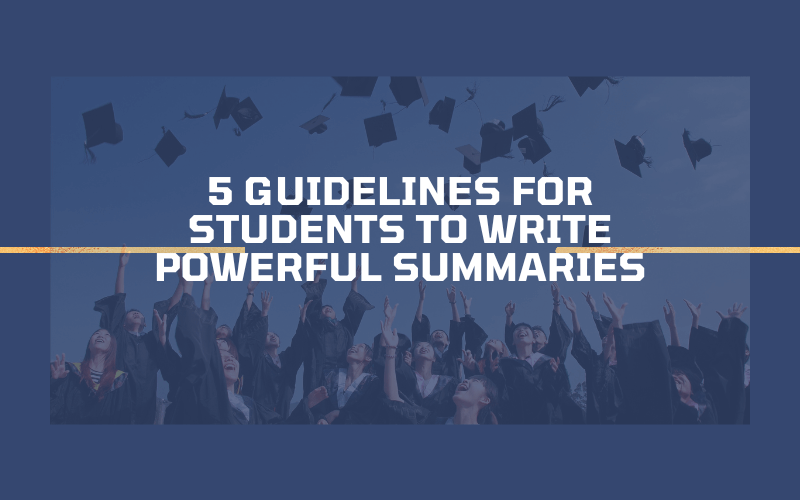Summarizing is an essential skill for students to learn, as it helps them to comprehend complex information quickly and efficiently. It involves reducing the content to its essential points, making it easier to understand, remember, and communicate with others. It is a critical tool in academic writing, research, and daily life.
The objective of this article is to provide five guidelines that students can follow to write powerful summaries. These guidelines will help students to develop their summarizing skills, enabling them to create effective and concise summaries that convey the key points of any given text.
The five guidelines that will be discussed in this article include:
- Know the purpose and content
- Start with a strong hook
- Focus on key points
- Keep it concise and clear
- Review and revise.
Know the Purpose and Content
To write a powerful summary, it is essential to understand why you are summarizing the content. Is it to provide a brief overview of the topic, to highlight the main points, or to provide an in-depth analysis of the text? By understanding the purpose of the summary, you can tailor your writing to meet the specific requirements of the task.
Before you start writing the summary, it is important to read and understand the content thoroughly. Identify the key ideas and details of the text, and make note of any supporting evidence or examples. This will help you to create a comprehensive and accurate summary.
Once you have identified the key ideas and details, highlight the most important information that needs to be included in the summary. Focus on the main points, and avoid getting bogged down in unnecessary details or tangents.
Start with a Strong Hook
To capture the reader’s attention, start your summary with an attention-grabbing opening statement. This could be a surprising fact, a provocative question, or a bold statement that sets the tone for the rest of the summary.
Follow the opening statement with a clear and concise thesis statement that summarizes the main point of the text. This should be one or two sentences that provide a roadmap for the rest of the summary.
Preview the main points that you will discuss in the summary. This will help the reader to understand what to expect and will keep them engaged throughout the summary.
Focus on Key Points
Focus on the main ideas of the text and identify the most important points that need to be included in the summary. These should be the ideas that are most relevant to the purpose of the summary.
Avoid including irrelevant information in the summary. Using a summarizing tool to stick to the key points and avoid getting sidetracked by minor details or tangents.
Use appropriate keywords and phrases to highlight the key points of the text. This will help the reader to understand the most important information at a glance.
Keep it Concise and Clear
Keep the language simple and easy to understand. Avoid using technical jargon or complex vocabulary that may confuse the reader. Repeating the same information over and over again can make the summary boring and uninteresting. Instead, use synonyms or different words to convey the same idea.
That not only makes the summary more interesting but also demonstrates your comprehension of the content. Using bullet points or numbered lists is an effective way to organize information in the summary. It helps to break down complex information into smaller, more manageable parts, making it easier for the reader to understand.
When using bullet points or numbered lists, make sure to keep them consistent throughout the summary. Use short, concise sentences and keep each point relevant to the main ideas of the content. This will make it easier for the reader to scan and locate the key points quickly.
Review and Revise
Before submitting the summary, proofread it for grammar, punctuation, and spelling errors. These mistakes can undermine the credibility of the summary and distract the reader from the key points.
Ensure that the summary is coherent and logical. The ideas should flow logically from one point to the next, and the summary should be easy to follow.
Verify the accuracy of the summary by checking it against the original text. Make sure that you have included all the key points and that you have not misrepresented the content.
Bottom Lines
Summarizing is an essential skill that students need to develop. It helps to improve comprehension, memory, and communication. To write powerful summaries, students need to follow these five guidelines. Writing a powerful summary takes practice and patience, but by following these guidelines, students can develop their summarizing skills and produce effective and compelling summaries. With these skills, students can excel in their academic and professional endeavors.
FAQs
Why is summarizing important for students?
Summarizing is important for students because it helps them to improve their comprehension and memory of the content they are reading. It also helps to develop communication skills, as summarizing requires the ability to convey information concisely and accurately.
What are the five guidelines for writing powerful summaries?
The five guidelines for writing powerful summaries are: know the purpose and content, start with a strong hook, focus on key points, keep it concise and clear, and review and revise.
How can I identify the key ideas and details of the content?
To identify the key ideas and details of the content, it is important to read the content carefully and take notes as you go along. Look for the main themes and ideas that are repeated throughout the content.
Should I use technical jargon and complex vocabulary in my summary?
No, you should avoid using technical jargon and complex vocabulary in your summary. Keep the language simple and easy to understand, and avoid confusing the reader with unfamiliar terms.
How can I make my summary more engaging?
To make your summary more engaging, you can use a strong hook to grab the reader’s attention and use synonyms or different words to convey the same idea to avoid repetition. You can also use bullet points or numbered lists to organize the information and make it easier to follow.


